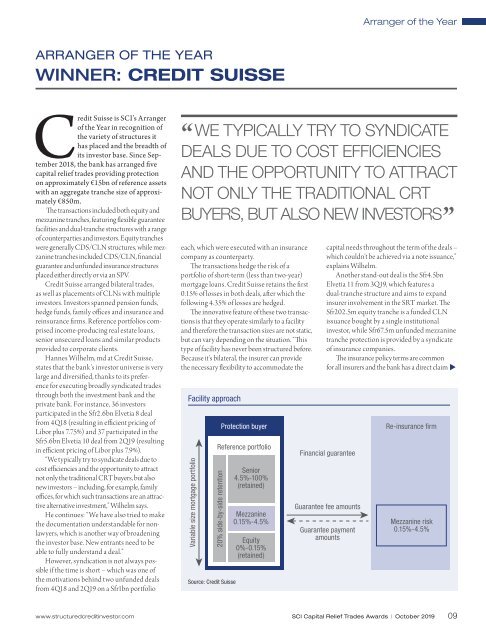SCI CRT Awards Issue Oct 19
You also want an ePaper? Increase the reach of your titles
YUMPU automatically turns print PDFs into web optimized ePapers that Google loves.
Arranger of the Year<br />
ARRANGER OF THE YEAR<br />
WINNER: CREDIT SUISSE<br />
Credit Suisse is <strong>SCI</strong>’s Arranger<br />
of the Year in recognition of<br />
the variety of structures it<br />
has placed and the breadth of<br />
its investor base. Since September<br />
2018, the bank has arranged five<br />
capital relief trades providing protection<br />
on approximately €15bn of reference assets<br />
with an aggregate tranche size of approximately<br />
€850m.<br />
The transactions included both equity and<br />
mezzanine tranches, featuring flexible guarantee<br />
facilities and dual-tranche structures with a range<br />
of counterparties and investors. Equity tranches<br />
were generally CDS/CLN structures, while mezzanine<br />
tranches included CDS/CLN, financial<br />
guarantee and unfunded insurance structures<br />
placed either directly or via an SPV.<br />
Credit Suisse arranged bilateral trades,<br />
as well as placements of CLNs with multiple<br />
investors. Investors spanned pension funds,<br />
hedge funds, family offices and insurance and<br />
reinsurance firms. Reference portfolios comprised<br />
income-producing real estate loans,<br />
senior unsecured loans and similar products<br />
provided to corporate clients.<br />
Hannes Wilhelm, md at Credit Suisse,<br />
states that the bank’s investor universe is very<br />
large and diversified, thanks to its preference<br />
for executing broadly syndicated trades<br />
through both the investment bank and the<br />
private bank. For instance, 36 investors<br />
participated in the Sfr2.6bn Elvetia 8 deal<br />
from 4Q18 (resulting in efficient pricing of<br />
Libor plus 7.75%) and 37 participated in the<br />
Sfr5.6bn Elvetia 10 deal from 2Q<strong>19</strong> (resulting<br />
in efficient pricing of Libor plus 7.9%).<br />
“We typically try to syndicate deals due to<br />
cost efficiencies and the opportunity to attract<br />
not only the traditional <strong>CRT</strong> buyers, but also<br />
new investors – including, for example, family<br />
offices, for which such transactions are an attractive<br />
alternative investment,” Wilhelm says.<br />
He continues: “We have also tried to make<br />
the documentation understandable for nonlawyers,<br />
which is another way of broadening<br />
the investor base. New entrants need to be<br />
able to fully understand a deal.”<br />
However, syndication is not always possible<br />
if the time is short – which was one of<br />
the motivations behind two unfunded deals<br />
from 4Q18 and 2Q<strong>19</strong> on a Sfr1bn portfolio<br />
“<br />
WE TYPICALLY TRY TO SYNDICATE<br />
DEALS DUE TO COST EFFICIENCIES<br />
AND THE OPPORTUNITY TO ATTRACT<br />
NOT ONLY THE TRADITIONAL <strong>CRT</strong><br />
BUYERS, BUT ALSO NEW INVESTORS<br />
”<br />
each, which were executed with an insurance<br />
company as counterparty.<br />
The transactions hedge the risk of a<br />
portfolio of short-term (less than two-year)<br />
mortgage loans. Credit Suisse retains the first<br />
0.15% of losses in both deals, after which the<br />
following 4.35% of losses are hedged.<br />
The innovative feature of these two transactions<br />
is that they operate similarly to a facility<br />
and therefore the transaction sizes are not static,<br />
but can vary depending on the situation. “This<br />
type of facility has never been structured before.<br />
Because it’s bilateral, the insurer can provide<br />
the necessary flexibility to accommodate the<br />
Facility approach<br />
Variable size mortgage portfolio<br />
Protection buyer<br />
Reference portfolio<br />
20% side-by-side retention<br />
Source: Credit Suisse<br />
Senior<br />
4.5%-100%<br />
(retained)<br />
capital needs throughout the term of the deals –<br />
which couldn’t be achieved via a note issuance,”<br />
explains Wilhelm.<br />
Another stand-out deal is the Sfr4.5bn<br />
Elvetia 11 from 3Q<strong>19</strong>, which features a<br />
dual-tranche structure and aims to expand<br />
insurer involvement in the SRT market. The<br />
Sfr202.5m equity tranche is a funded CLN<br />
issuance bought by a single institutional<br />
investor, while Sfr67.5m unfunded mezzanine<br />
tranche protection is provided by a syndicate<br />
of insurance companies.<br />
The insurance policy terms are common<br />
for all insurers and the bank has a direct claim<br />
Financial guarantee<br />
Re-insurance firm<br />
Guarantee fee amounts<br />
Mezzanine<br />
0.15%-4.5% Mezzanine risk<br />
Guarantee payment<br />
0.15%-4.5%<br />
Equity<br />
amounts<br />
0%-0.15%<br />
(retained)<br />
www.structuredcreditinvestor.com<br />
<strong>SCI</strong> Capital Relief Trades <strong>Awards</strong> | <strong>Oct</strong>ober 20<strong>19</strong><br />
09




